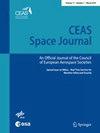Assessment of radiation shielding properties of self-healing polymers and nanocomposites for a space habitat case study under GCR and LEO radiation
IF 1.8
Q2 ENGINEERING, AEROSPACE
引用次数: 0
Abstract
Abstract In recent decades, the opportunity to introduce self-healing materials within space structures has drawn the attention of scientists and companies. Autonomous repair following damage caused by impacts with micrometeoroids and orbital debris (MMOD) would lead to safer human activity in space and would increase spacecraft operational life and autonomy, thus reducing replacement costs and possibly relieving astronauts from maintenance activities. In particular, integrating self-healing materials into structures to protect humans from the space environment is a fundamental step in the realization of long-lasting space exploration missions. Nevertheless, the way these materials interact with the environmental factors in space still needs to be properly analyzed and understood; in particular, space radiation is a serious threat to human health and material integrity. The proposed work hence investigates the shielding ability of candidate self-healing materials with the specific purpose of human protection in crewed missions. The NASA HZETRN2015 (High Z and Energy TRaNsport, 2015 version) software is used to simulate galactic cosmic rays (GCR) and low Earth orbit (LEO) environment. A comparison between a standard habitat layup proposed by NASA and a set of configurations containing self-healing polymers is performed to verify that the substitution of conventional bladder materials with the proposed self-healing solutions does not decrease the overall habitat shielding performance. A self-healing nanocomposite option with single-walled carbon nanotubes (SWCNTs) is also analyzed to determine whether the insertion of nanofillers can increase the overall shielding performance. In the second phase, the comparison of puncture tests on blank and irradiated samples under conditions reproducing a space suit example is presented to assess the possible effects of radiation on the self-healing performance.空间栖息地GCR和LEO辐射下自修复聚合物和纳米复合材料的辐射屏蔽性能评估
近几十年来,在空间结构中引入自修复材料的机会引起了科学家和公司的注意。微流星体和轨道碎片(MMOD)撞击造成损坏后的自主修复将使人类在太空中的活动更加安全,并将延长航天器的使用寿命和自主性,从而降低更换成本,并可能使宇航员免于维护活动。特别是,将自我修复材料整合到结构中以保护人类免受空间环境的影响是实现长期空间探索任务的基本步骤。然而,这些材料与空间环境因素相互作用的方式仍然需要适当的分析和理解;特别是,空间辐射对人类健康和物质完整性构成严重威胁。因此,拟议的工作是研究候选自愈材料在载人飞行任务中具有保护人类特定目的的屏蔽能力。NASA HZETRN2015 (High Z and Energy TRaNsport, 2015 version)软件用于模拟银河宇宙射线(GCR)和低地球轨道(LEO)环境。将NASA提出的标准栖息地铺层与一组包含自修复聚合物的配置进行比较,以验证用提出的自修复解决方案替代传统的膀胱材料不会降低整体栖息地屏蔽性能。本文还分析了单壁碳纳米管(SWCNTs)的自修复纳米复合材料选项,以确定纳米填料的插入是否可以提高整体屏蔽性能。在第二阶段,提出了在再现航天服样品的条件下对空白样品和辐照样品进行穿刺试验的比较,以评估辐射对自修复性能可能产生的影响。
本文章由计算机程序翻译,如有差异,请以英文原文为准。
求助全文
约1分钟内获得全文
求助全文
来源期刊

CEAS Space Journal
ENGINEERING, AEROSPACE-
CiteScore
3.90
自引率
7.10%
发文量
67
期刊介绍:
The CEAS Space Journal has been created by the CEAS Space Branch to provide an appropriate platform for the excellent scientific publications submitted by scientists and engineers. Under the umbrella of CEAS, the German Aerospace Center (DLR) and the European Space Agency (ESA) support the Journal. The Journal is devoted to new developments and results in all areas of space-related science and technology, including important spin-off capabilities and applications as well as ground-based support systems and manufacturing advancements. Of interest are also (invited) in-depth reviews of the status of development in specific areas of relevance to space, and descriptions of the potential way forward. Typical disciplines of interest include mission design and space systems, satellite communications, aerothermodynamics (including physical fluid dynamics), environmental control and life support systems, materials, operations, space debris, optics, optoelectronics and photonics, guidance, navigation and control, mechanisms, propulsion, power, robotics, structures, testing and thermal issues and small satellites. The Journal publishes peer-reviewed original articles, (invited) reviews and short communications.
 求助内容:
求助内容: 应助结果提醒方式:
应助结果提醒方式:


